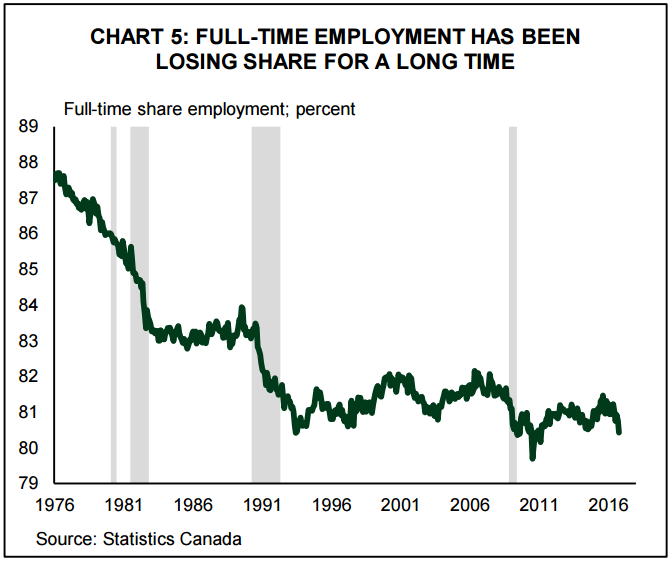Regina, Sask.

It’s not a city many would likely expect to top economic rankings of any kind at a time of low oil prices. It is, after all, the capital of a resource-dependent province whose economy has suffered as prices dropped in recent years.
Indeed, the province’s unemployment rate went up last year.
But data released by Statistics Canada last week brought comparatively good news for the capital — it had the highest full-time employment rate of any major metropolitan area across Canada in December 2016.
READ MORE: Canada created lots of jobs last year. Almost all were part-time: TD
Regina registered a 57.2 per cent full-time employment rate last month; it was followed by Guelph, Ont., with 55.9 per cent, and Ontario’s Kitchener-Cambridge-Waterloo area, with 55.3 per cent.
The rates, which are available in this StatsCan table, are not seasonally adjusted and were determined by dividing each city’s full-time employment by its population.
But it nevertheless gives people an indication of where Canadians are holding on to full-time work, even as it shrinks as a proportion of total employment.
“Even with relatively difficult economic times, the underlying structure of the economy is important.”
TD senior economist James Marple, who last week released a report showing that almost every job created in Canada last year was part-time, didn’t explain precisely why Regina ended up on top of the list, in an email to Global News.
He did, however, say that cities’ employment numbers don’t always sway with fluctuations in the economy.
“Even with relatively difficult economic times, the underlying structure of the economy is important,” he said.
It may be that Regina, and other cities high up on the list, “have had a higher ratio of full-time jobs for a relatively long time,” Marple added.
Fluctuations
Regina’s full-time employment rate in December has fluctuated over the past 15 years, hitting a low of 52.8 per cent in 2005 and a high of 60.5 per cent in 2011.
It forms a marked contrast with full-time employment in Calgary, which has a more obvious correlation with economic circumstances.
The city’s full-time employment rate fell from just under 62 per cent in December 2007 to 52.2 per cent in December 2008, the year that the financial crisis hit.
The graph below illustrates the contrast between Regina and Calgary’s employment rates.
Full-time work as a share of total employment has been falling steadily since the 1980s, said Marple’s report, which he co-authored with TD chief economist Beata Caranci.
There are numerous reasons why this is happening. One is that the service industry has come to occupy a larger share of employment.
And it’s a sector that is known to generate a “greater share of part-time positions,” TD noted.

In other words, it’s a tough market for full-time work out there, and it’s growing tougher.
And some Canadian cities are clearly riding out the trend better than others.
Here are the best Canadian cities for full-time jobs:
1) Regina, Sask. — 57.2 per cent
Population (Dec. 2016): 202,700
Full-time employment: 116,100
Full-time employment rate: 57.2 per cent
2) Guelph, Ont. — 55.9 per cent
Population (Dec. 2016): 131,200
Full-time employment: 73,400
Full-time employment rate: 55.9 per cent
3) Kitchener-Cambridge-Waterloo, Ont. — 55.3 per cent
Population (Dec. 2016): 428,200
Full-time employment: 236,900
Full-time employment rate: 55.3 per cent
4) Edmonton, Alta. — 54.2 per cent
Population (Dec. 2016): 1,127,400
Full-time employment: 610,700
Full-time employment rate: 54.2 per cent
5) Calgary, Alta. — 53.8 per cent
Population (Dec. 2016): 1,210,300
Full-time employment: 650,800
Full-time employment rate: 53.8 per cent
6) Oshawa, Ont. — 53.6 per cent
Population (Dec. 2016): 329,200
Full-time employment: 176,400
Full-time employment rate: 53.6 per cent
7) Quebec City, Que. — 53.1 per cent
Population (Dec. 2016): 677,500
Full-time employment: 360,300
Full-time employment rate: 53.1 per cent
8) Saint John, N.B. — 52.9 per cent
Population (Dec. 2016): 105,400
Full-time employment: 55,800
Full-time employment rate: 52.9 per cent
9) Ottawa-Gatineau, Ont./Que. — 50.9 per cent

Population (Dec. 2016): 1,116,300
Full-time employment: 568,600
Full-time employment rate: 50.9 per cent
10) Toronto, Ont. — 50.3 per cent
Population (Dec. 2016): 5,231,800
Full-time employment: 2,631,600
Full-time employment rate: 50.3 per cent

















Comments